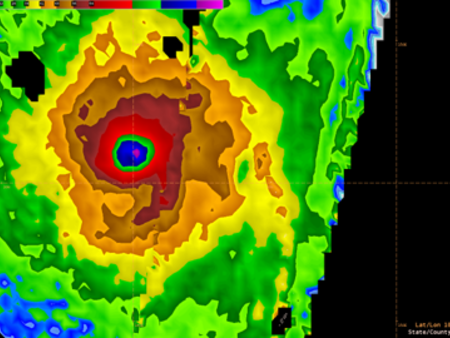Validation
SMOS High wind speed products are validated against a range of observations including:
•Best Track parameters such as:
Max Wind Speed
Wind Radii
•NDBC buoys surface winds
•SFMR flight transect measurements of surface winds
• Altimeter winds
The validation analysis is still in progress and detailed report will be available later on but we provide here few illustrative examples of the comparisons between SMOS retrieved surface winds and independant observations:
Validation Metric 1: Example of Maximum sustained Wind Comparisons between SMOS products and Best Track data (Ibtracks)
Figure 1: plot showing the SMOS maximum wind compared to Best Track reported Maximum wind speed for the North Atlantic intercepts of Hurricane season 2012. Note that this is a preliminary result as no filter has been applied on SMOS data which might include still partial Storm intercepts and RFI contaminated data.
Figure 2: Maximum sustained 1 minute wind speed estimated during Haiyan Typhoon in Nov 2013. From SMOS data (black filled dots) compared to Advanced Dvorak Technique (ADT=blue diamond), CIMSS (yellow filled dots), SATCON (red) and Best Track from NHC (cyan). Note the empty circle correspond to the SMOS measurements for the 11/06 morning for which only a small portion of the cyclone signal was intercepted. Maximum 10 minutes wind speed deduced from SMOS algorithm were multiplied by 1/0.93, adopting the conversion factor proposed in (Harper et al., 2010) between one minute winds and 10 min winds.
Validation Metric 2: Example of Wind radii Comparisons between SMOS products and other data sets (Best Track data, H*WIND, GFDL model..)
Figure 3: Median values of the surface wind speed Radii evaluated over the four Storm quadrants of Hurricane Cat 4 Igor in Sep 2010 as function of days at 34 knots (a), 50 knots (b) and 64 knots (c). Symbols for the radii from the different wind products are: GFDL model (solid black triangles), H*WIND products (gray squares), SMOS estimated winds (solid white circles) and NHC/ATCF best-track estimates (thick black curves). Note that both GFDL model and H*WIND products were spatially averaged at 50 km, the SMOS averaged spatial resolution. see [Reul et al., JGR 2012].
Validation Metric 3: Example of Surface Wind Comparisons between SMOS retrievals and 10 m wind from NOAA NDBC buoys
Figure 4: Right: location of the buoys superimposed on the SMOS retrieved wind speed for the 27th Oct at 23:05 UTC.Left: Time Series of the Surface Wind Speed measured at several meteorological buoys(black curves) of the NOAA NDBC array (National Data Buoy Center) as the Category 1 Hurricane Sandy passed between US coasts and the Bermuda Islands. Local estimates of the surface wind speed from SMOS data are illustrated by red dots.
Validation Metric 4: Example of Surface Wind Comparisons between SMOS and SFMR flight retrievals
Figure 5: Top: SMOS estimated surface wind speed as the satellite overpassed Hurricane Sandy the 28th Oct 2012 at 09:56 UTC. The track of the NOAA 42 P-3 aircraft flight is superimposed (black curves). White dots indicates the aircraft location at successive times with respect to SMOS acquisition. Bottom: Co-located SFMR (black) and SMOS (red) surface wind speed estimates along the P-3 track. SFMR estimated rain rate is also shown in grey [mm/h]. Click on the images to see larger views.
Figure 6: Top: SMOS estimated surface wind speed as the satellite overpassed Hurricane Leslie the 7th Sep 2012 at 22:19 UTC. The track of the NOAA 42 P-3 aircraft flight is superimposed (black curves). White dots indicates the aircraft location at successive times with respect to SMOS acquisition. Bottom: Co-located SFMR (black) and SMOS (red) surface wind speed estimates along the P-3 track. SFMR estimated rain rate is also shown in grey [mm/h]. The Sfmr data smoothed at SMOS spatial resolution (~40 km) is shown in blue. Click on the images to see larger views.


